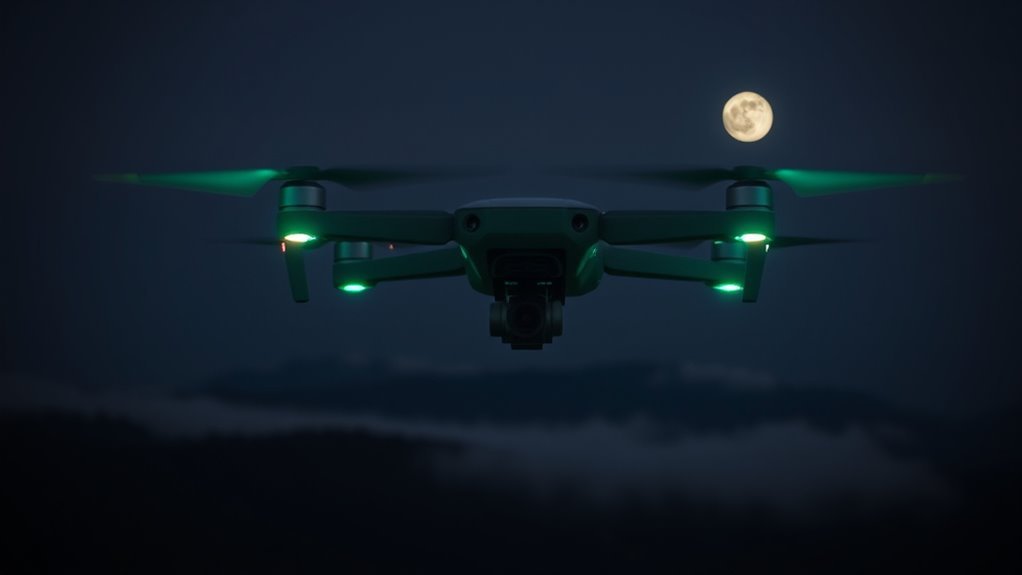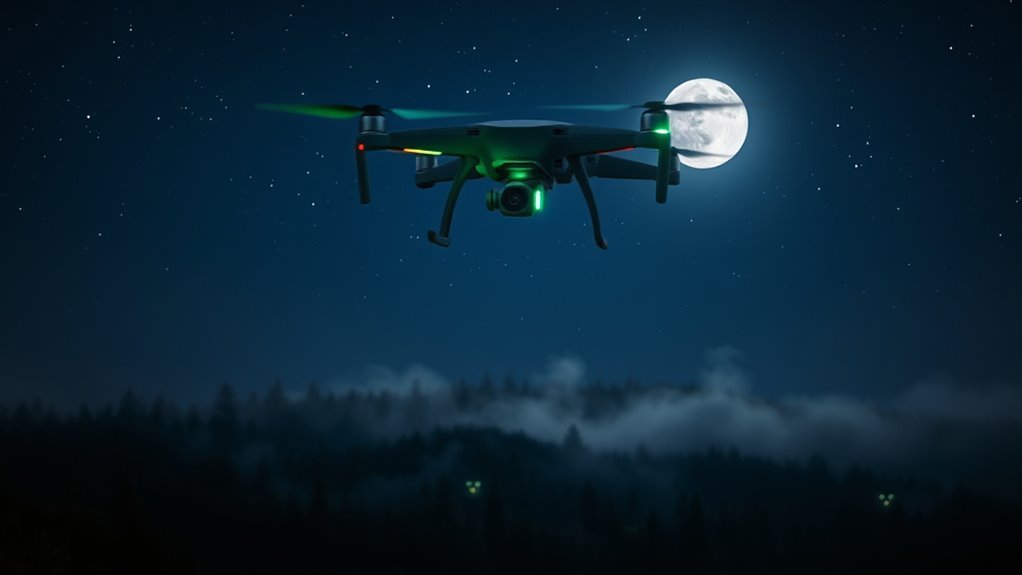Drones have several night vision options, including thermal imaging, low-light imaging, and image intensification. Thermal imaging detects heat signatures, which is ideal for tactical missions and wildlife monitoring. Low-light imaging enhances visibility in limited light, useful for surveillance operations. Image intensification amplifies available light, enabling effective performance in near darkness. Each option has its specific advantages for various applications. Understanding these differences can help you choose the best system for your needs, guiding your next decisions.
Understanding Night Vision Technology

Although night vision technology has advanced markedly, understanding its fundamentals is essential for effectively utilizing it in drones. Night vision basics encompass two main types: image intensification and digital night vision. Image intensification amplifies available light, allowing you to see in low-light conditions. This technology relies on photomultiplier tubes to convert photons into electrons, effectively enhancing visibility. On the other hand, digital night vision uses sensors to capture infrared light and convert it into a visible image. Technology advancements in these areas have improved resolution, range, and overall performance, giving you greater freedom to conduct nighttime operations. Knowing these differences helps you choose the right system for your drone, ensuring peak performance in various environments and conditions.
Thermal Imaging

Thermal imaging represents a crucial advancement in nighttime surveillance and reconnaissance for drones, enabling operators to detect heat signatures emitted by objects and living beings. With its superior thermal resolution, this technology allows you to discern minute temperature variations, making it indispensable for search and rescue operations, wildlife monitoring, and tactical missions. Utilizing infrared detection, drones equipped with thermal cameras can penetrate darkness and obscured environments, providing clear visual data where traditional optics fail. This capability not only enhances situational awareness but also enables swift decision-making in critical scenarios. As you harness thermal imaging, you gain an unparalleled advantage in analyzing and responding to dynamic situations, ensuring efficiency and effectiveness in your operations. Furthermore, drones like the Teal 2 feature superior thermal resolution, allowing for clearer images that enhance detailed analysis during critical missions. Notably, the Teal 2 detects temperature variations down to 0.05°C, which significantly boosts tactical precision in diverse environments.
Low-Light Imaging

Low-light imaging is an essential technology for drones operating in environments where visibility is limited but illumination is still present, such as during twilight or in partially lit areas. These systems leverage advanced sensors to enhance low-light capabilities, allowing drones to capture clear images and video even when natural light is scarce. During nighttime operations, this technology becomes critical for tasks like surveillance, search and rescue, and agricultural monitoring. The ability to detect and interpret low-light conditions expands operational flexibility, enabling you to perform missions that would otherwise be hindered by darkness. By integrating low-light imaging, drones can navigate complex environments, ensuring that you maintain situational awareness regardless of lighting conditions, thereby maximizing their effectiveness and your freedom in the field. Additionally, Brinc’s thermal imaging enhances visibility by detecting heat signatures, which can be invaluable during low-light rescue operations. Furthermore, drones equipped with advanced sensors can transform inspection processes, capturing high-quality visuals even in challenging environments.
Image Intensification
Image intensification is a pivotal technology for enhancing the capabilities of drones in low-light conditions. This technique amplifies available light, improving visibility markedly, even in near darkness. By utilizing various image enhancement techniques, drones can operate effectively during nighttime or in shadowy environments.
| Feature | Benefits | Applications |
|---|---|---|
| Light Amplification | Increases visibility | Surveillance |
| Low Light Performance | Enhances detail recognition | Search and Rescue |
| Compact Design | Fits various drone models | Military Recon |
| Cost-Effective | Reduces need for expensive sensors | Commercial Use |
| Durability | Withstands harsh environments | Environmental Monitoring |
With image intensification, you gain an edge in low-light performance, allowing for greater operational freedom and efficiency.
Advantages of Night Vision Drones
Drones equipped with night vision technology offer significant advantages for various applications, particularly in challenging visibility conditions. You can enhance night surveillance capabilities, allowing for real-time monitoring of areas that would otherwise remain inaccessible. This technology enables you to gather critical data without disturbing the environment, making it invaluable for wildlife monitoring. By utilizing infrared sensors, these drones can detect heat signatures, providing insights into animal behaviors and habitat usage during nighttime. Moreover, their ability to operate in low-light conditions enhances operational efficiency for search and rescue missions. The integration of night vision not only expands your operational scope but also empowers you to make informed decisions based on thorough environmental assessments, ensuring a balance between exploration and conservation.
Applications of Night Vision Drones
Night vision technology greatly expands the range of applications for aerial surveillance and reconnaissance. With drones equipped for low-light environments, you can greatly enhance search and rescue operations. These drones provide real-time thermal imaging, enabling teams to locate missing persons in challenging terrains, even during nighttime. Additionally, wildlife monitoring becomes more efficient with night vision capabilities. You can track animal movements, gather data on nocturnal behavior, and prevent poaching activities without disturbing habitats. The precision offered by night vision drones allows for detailed analysis while ensuring minimal impact on wildlife. By leveraging these advanced technologies, you’re not only improving operational effectiveness but also promoting conservation efforts, thereby fostering a sense of freedom for both humans and wildlife alike.
Choosing the Right Night Vision Option for Your Drone
When selecting a night vision option for your drone, you’ll need to evaluate the specific capabilities of thermal imaging cameras, low-light sensors, and night vision goggles. Each technology presents unique advantages and limitations that can greatly impact performance in varying conditions. Understanding these differences will help you make an informed decision based on your operational requirements.
Thermal Imaging Cameras
While selecting the right night vision option for your drone, thermal imaging cameras stand out for their ability to detect heat signatures, making them invaluable in various applications such as search and rescue, wildlife monitoring, and infrastructure inspection. Utilizing infrared technology, these cameras capture temperature variations, allowing you to identify objects and living beings in complete darkness. When choosing a thermal imaging camera, consider the thermal resolution, which directly impacts the clarity of the images produced. Higher resolution guarantees better detail, essential for accurate assessments in critical situations. With the increasing accessibility of this technology, integrating thermal imaging into your drone setup can enhance your operational capabilities, granting you the freedom to conduct thorough and effective aerial surveillance.
Low-Light Sensors
For those looking to enhance their drone’s night vision capabilities, low-light sensors offer a compelling alternative to thermal imaging. These sensors excel in low light performance, allowing you to capture detailed images in challenging lighting conditions. By maximizing sensor sensitivity, they can detect subtle variations in light, which is essential for tasks like surveillance and search-and-rescue operations. Unlike thermal imaging, which relies on heat signatures, low-light sensors provide real-time visual data, making them ideal for environments where color and detail matter. When choosing a low-light sensor for your drone, consider factors such as resolution, frame rate, and the specific conditions you’ll encounter. This way, you can guarantee your drone operates effectively, even when the sun goes down.
Night Vision Goggles
Selecting the right night vision goggles for your drone can greatly enhance your operational capabilities after dark. When evaluating goggle types, consider options like Gen 1, Gen 2, and Gen 3, each offering different levels of clarity and sensitivity. Gen 3 goggles, for example, excel in low-light environments, providing superior image quality for critical usage scenarios such as search and rescue or surveillance. Assess your specific needs—if you’re operating in dense foliage or urban areas, a wider field of view may be essential. Additionally, verify compatibility with your drone’s payload and operational range. Ultimately, the right pair of goggles will not only elevate your drone’s functionality but also grant you the freedom to explore and operate effectively in the dark.
Frequently Asked Questions
Can Night Vision Drones Operate in Complete Darkness?
Yes, night vision drones can operate in complete darkness using infrared cameras and thermal imaging. These technologies detect heat signatures, enabling you to monitor environments where visible light is absent, enhancing your operational capabilities considerably.
How Much Do Night Vision Drone Systems Typically Cost?
When you consider night vision pricing, it’s like traversing a labyrinth; drone system costs typically range from a few thousand to tens of thousands, depending on features, technology, and the intended application.
Are Night Vision Drones Legal to Use for Personal Purposes?
Yes, night vision drones can be legal for personal use, but you must comply with drone regulations. Always check local laws and restrictions to guarantee you’re operating within the legal framework for your specific area.
How Far Can Night Vision Drones See at Night?
Night visibility range in drones varies based on sensor technology, typically extending from a few hundred meters to several kilometers. Enhanced drone performance in low-light conditions allows for effective surveillance, navigation, and data collection at night.
What Are the Limitations of Night Vision Technology in Drones?
While you’re exploring night vision tech, remember that thermal imaging can struggle with sensor limitations. Factors like environmental conditions, range, and resolution can hinder effectiveness, making it essential to understand these constraints for ideal drone operations.

